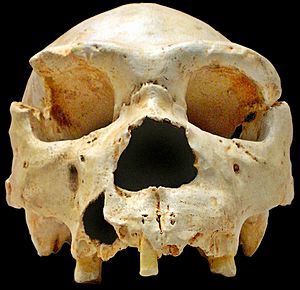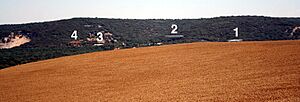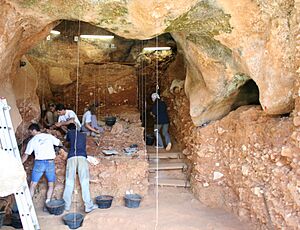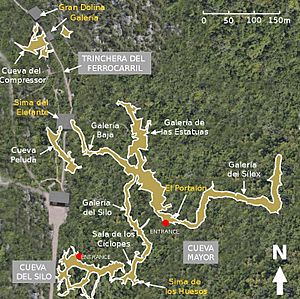Archaeological site of Atapuerca facts for kids
| UNESCO World Heritage Site | |
|---|---|

Karst cave in Atapuerca
|
|
| Official name | Archaeological Site of Atapuerca |
| Location | Atapuerca, Burgos |
| Part of | Atapuerca Mountains |
| Criteria | Cultural |
| Inscription | 2000 (24th Session) |
The Archaeological Site of Atapuerca is a very important place in northern Spain. It is located in the province of Burgos. This site is famous for showing us how early humans lived.
Scientists found bone pieces here that are about 800,000 years old. These are the oldest signs of early humans, called hominids, in Western Europe. They also show the earliest known example of cannibalism anywhere in the world.
Because of its importance, Atapuerca was named a World Heritage Site in 2000. This means it is a special place protected by UNESCO.
Contents
- Discovering Atapuerca's Secrets
- Protecting and Visiting the Site
- Exploring the Dig Sites
- Portalón Cave: Ancient Pottery Finds
- Galería de la Eduarda y el Kolora: Hidden Cave Art
- Galería: Home of Homo heidelbergensis
- Gran Dolina: Evidence of Early Cannibalism
- Sima de los Huesos: The Pit of Bones
- Sima del Elefante: The Earliest Europeans?
- Cueva del Mirador: Early Farmers and Shepherds
- Orchids Valley and Hundidero: Stone Age Tools
- Cueva fantasma: Neanderthal Finds
- Galería de las estatuas: More Neanderthal Evidence
- See also
Discovering Atapuerca's Secrets
The importance of this area in Burgos became clear in the 20th century. This happened when a metre-gauge railway was built through the Atapuerca Mountains. The railway construction cut deep into the ground. These cuts revealed caves and layers of rock. These areas are now known as Gran Dolina, Galería Elefante, and Sima de los Huesos.
In 1964, Francisco Jordá Cerdá led the first big dig. His team found tools made by humans and human fossils. These finds came from many different time periods. They included early humans, hunter-gatherer groups, and people from the Bronze Age.
More digs followed, with many scientists working together. Emiliano Aguirre led the work from 1978 to 1990. Later, Eudald Carbonell, José María Bermúdez de Castro, and Juan Luis Arsuaga took over. Their work proved that humans lived in this area for a very long time. In 2020, two quartzite stones were found. They were 600,000 years old. This discovery helped fill a gap in the human history of the site. It showed human presence for 1,200,000 years.
Protecting and Visiting the Site
The Atapuerca site is protected in several ways. UNESCO named it a World Heritage Site. Spain also protects it as a Zona Arqueológica. This is a special type of heritage site. The region of Castile and León calls the Sierra de Atapuerca an Espacio cultural.
This special protection helps allow people to visit the local villages. It also helps with sustainable tourism. You can visit the Site Access Centre (CAYAC) in Ibeas de Juarros. There is also an Experimental Archaeology Centre (CAREX) in the village of Atapuerca. Many of the amazing finds from Atapuerca are displayed at the Museum of Human Evolution in the city of Burgos.
Exploring the Dig Sites
Scientists have been digging at several important spots within Atapuerca. Each site tells us a different part of the human story.
Portalón Cave: Ancient Pottery Finds
Archaeologists have worked at the Portalón cave since 1910. They found many ceramic objects here. These objects come from different time periods, including the Neolithic age.
Galería de la Eduarda y el Kolora: Hidden Cave Art
This cave was found in 1972 by local cave explorers. It contains ancient rock paintings. These are also known as parietal rock paintings.
Galería: Home of Homo heidelbergensis
This site has been excavated since 1978. Many animal and plant fossils were found here. In the 1970s, a jaw piece was discovered. In 1995, a skull piece was found. Both belonged to Homo heidelbergensis. These remains are between 600,000 and 400,000 years old.
Gran Dolina: Evidence of Early Cannibalism
The Gran Dolina site is a very large cave. Digging here started in 1981. Its layers of soil are divided into eleven sections (TD-1 to TD-11).
- TD-11: Here, scientists found Mousterian tools.
- TD-10: This level might have been a camp for Homo heidelbergensis. Tools and bison fossils were found here.
- TD-8: This level, reached in 1994, had many carnivore fossils.
- TD-7: In 1994, a bovine (cow-like animal) leg was found in its natural position.
- TD-6 (Aurora stratum): This is a very important level. Since 1994, over 160 bone pieces from at least eleven hominids were found. These bones are between 850,000 and 780,000 years old. This makes them the oldest hominid remains found in Western Europe. More than 30% of the bones show cut marks. These marks suggest cannibalism. Scientists are still discussing which human species these bones belong to. Some think they are Homo erectus, Homo heidelbergensis, or Homo antecessor. Some researchers believe Homo antecessor might be an ancestor of Homo heidelbergensis. Homo heidelbergensis then led to Homo neanderthalensis. Stone tools were also found here.
- The hominid bones clearly show signs of being cut and eaten. This was done in the same way as animal bones found in this layer. All the human bones belonged to young individuals, from babies to teenagers. Scientists think this was "nutritional" cannibalism. This means people from other groups were hunted and eaten like animals. It seems to have been a regular practice, not just because of hunger. Young individuals were likely targeted because they were less risky to hunt. This also helped limit the growth of rival groups.
- TD-5: This level is thought to have been a den for carnivores.
- TD-4: In 1991, four stone tools were found here. Also, remains of Ursus dolinensis, a type of bear, were discovered. This level is about 780,000 years old.
- TD-1 and TD-2: No fossils were found in these lowest levels.
Sima de los Huesos: The Pit of Bones
The Sima de los Huesos (Pit of Bones) is a key site. It has led to many important discoveries. This site is at the bottom of a 13-meter (43 ft) deep shaft. You can reach it through narrow tunnels in the Cueva Mayor.
Since 1997, over 5,500 human bones have been found here. They are from the Middle Pleistocene period, at least 350,000 years old. These bones belong to 28 individuals of Homo heidelbergensis. Some scientists also classify them as early Neanderthals. Other finds include Ursus deningeri fossils and a hand axe called Excalibur. Many experts believe this red quartzite axe was a ritual offering, perhaps for a funeral. This idea has sparked much discussion about early human thinking. Ninety percent of all known Homo heidelbergensis fossils come from this site. The pit includes:
- Complete skulls like Skull 5, nicknamed Miguelón.
- Parts of Skull 4 (Agamenón) and Skull 6 (Rui).
- A complete pelvis (Pelvis 1), nicknamed Elvis.
- Many jawbones, teeth, and other bones (like thigh bones, hand and foot bones, spines, ribs).
- Bones of a child with craniosynostosis were found. This condition affects skull growth. The bones are 530,000 years old. This find suggests that early humans cared for individuals with disabilities.
- In 2013, Mitochondrial DNA (mtDNA) from a 400,000-year-old femur was studied. This is the oldest hominin mtDNA ever found. It was more like the mtDNA of Denisova hominins than Neanderthals.
- However, in 2016, nuclear DNA tests showed these hominins were Neanderthals. This means Neanderthals and Denisovans separated more than 430,000 years ago.
- In 2019, studies of Neanderthal teeth from Sima de los Huesos suggested that modern humans and Neanderthals split from a common ancestor over 800,000 years ago.
- In 2020, tooth enamel analysis showed that Atapuerca hominids grew faster than modern humans.

Some scientists think the way bones are grouped in the pit suggests early humans had a burial culture. Another idea is that the bones were washed into the pit by natural forces. This is because small bones are missing from the collection.
Sima del Elefante: The Earliest Europeans?
This site is very important for understanding the first humans in Western Europe. José María Bermúdez de Castro, a research co-director, says findings here show "anatomical evidence of the hominids that fabricated tools more than one million years ago."
In 2007, a tooth was found. In 2008, a 1.2-million-year-old jawbone (mandible) and a toe bone were discovered. In 2022, archaeologists announced finding a 1.4-million-year-old upper jawbone (maxilla) with a tooth. This was found about two meters deeper than the 2008 fossils. Paleoanthropologist Eudald Carbonell thinks this jawbone might belong to Homo erectus. Other researchers suggest it could be from Homo antecessor.
Cueva del Mirador: Early Farmers and Shepherds
This site tells us about the first farmers and herders in the area. These people lived during the late Neolithic and Bronze Age.
Orchids Valley and Hundidero: Stone Age Tools
Stone tools from the Upper Paleolithic period have been found at these locations.
Cueva fantasma: Neanderthal Finds
At this site, scientists have found a Homo neanderthalensis skull fossil. They have also found stone tools.
Galería de las estatuas: More Neanderthal Evidence
This site contains Mousterian tools. It also has bones and DNA remains of Homo neanderthalensis.
See also
 In Spanish: Sitio arqueológico de Atapuerca para niños
In Spanish: Sitio arqueológico de Atapuerca para niños
- Museum of Human Evolution




